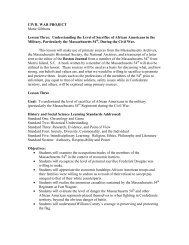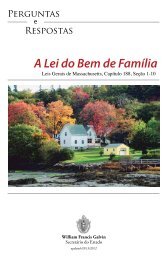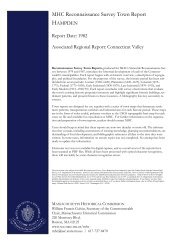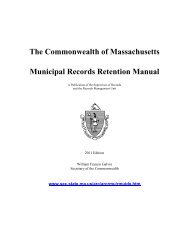Roads, Rails, and Trails - Secretary of the Commonwealth
Roads, Rails, and Trails - Secretary of the Commonwealth
Roads, Rails, and Trails - Secretary of the Commonwealth
Create successful ePaper yourself
Turn your PDF publications into a flip-book with our unique Google optimized e-Paper software.
The archaeologists took samples <strong>of</strong> <strong>the</strong> charcoal <strong>and</strong><br />
sent <strong>the</strong>m to a laboratory for radiocarbon dating. The results <strong>of</strong><br />
<strong>the</strong> analysis concluded that <strong>the</strong> pit was used around 3,200 years<br />
ago. This was a time archaeologists call <strong>the</strong> Late Archaic<br />
period. During this time, <strong>the</strong> Native people <strong>of</strong> New Engl<strong>and</strong><br />
lived by hunting, ga<strong>the</strong>ring, <strong>and</strong> fishing, moving <strong>the</strong>ir<br />
dwellings from season to season, based on <strong>the</strong>ir detailed<br />
knowledge <strong>of</strong> <strong>the</strong> l<strong>and</strong>, its resources, <strong>and</strong> its seasonal changes.<br />
This point tip made <strong>of</strong> quartzite was <strong>the</strong> only finished tool<br />
found at <strong>the</strong> site.<br />
25<br />
Much Late Archaic technology does not preserve well.<br />
Baskets, fabrics, wooden objects, bone tools <strong>and</strong> ornaments,<br />
<strong>and</strong> items <strong>of</strong> lea<strong>the</strong>r all decay rapidly in our climate <strong>and</strong> soils<br />
<strong>and</strong> are only preserved under very unusual circumstances.<br />
What does preserve is stone, <strong>and</strong> we know that <strong>the</strong> people<br />
made <strong>and</strong> used a wide variety <strong>of</strong> stone tools <strong>and</strong> even<br />
ornaments. Stone was shaped by flaking to make tools for<br />
cutting, scraping, <strong>and</strong> piercing, <strong>and</strong> to tip spears. Heavier tools<br />
like axes <strong>and</strong> gouges were shaped <strong>and</strong> sharpened by grinding,<br />
<strong>and</strong> s<strong>of</strong>t soapstone was carved into bowls, pots, pipes, <strong>and</strong><br />
ornaments.<br />
The Franklin County Bikeway Site contained only one<br />
finished stone tool, <strong>the</strong> broken tip <strong>of</strong> a spearpoint, which was<br />
made <strong>of</strong> a hard stone called quartzite. This particular variety <strong>of</strong><br />
quartzite is found in many parts <strong>of</strong> Vermont <strong>and</strong> northwestern<br />
Massachusetts. The flakes included several different types <strong>of</strong><br />
stone in addition to <strong>the</strong> quartzite. Some <strong>of</strong> <strong>the</strong> material would<br />
have been available locally. O<strong>the</strong>r stone would have been<br />
brought in from <strong>the</strong> Hudson Valley. So <strong>the</strong> types <strong>of</strong> stone found<br />
here reflect something <strong>of</strong> <strong>the</strong> trade networks <strong>of</strong> <strong>the</strong> Late<br />
Archaic people.<br />
Once <strong>the</strong> archaeologists had determined <strong>the</strong> size <strong>of</strong> <strong>the</strong><br />
site <strong>and</strong> excavated <strong>the</strong> feature <strong>and</strong> a sample <strong>of</strong> artifacts, it was<br />
up to <strong>the</strong> Massachusetts Highway Department <strong>and</strong> <strong>the</strong><br />
Massachusetts Historical Commission to decide whe<strong>the</strong>r or not<br />
fur<strong>the</strong>r excavation was warranted. The archaeologists had<br />
recommended that because <strong>the</strong> site was so small, <strong>the</strong><br />
excavations that had already been done were sufficient; more<br />
excavations weren’t likely to yield important new information.<br />
The state agencies agreed that no fur<strong>the</strong>r excavation was<br />
needed. Today, bikers roll across <strong>the</strong> Franklin Country<br />
Bikeway site, where travelers once paused thous<strong>and</strong>s <strong>of</strong> years<br />
before <strong>the</strong> invention <strong>of</strong> <strong>the</strong> bicycle.








